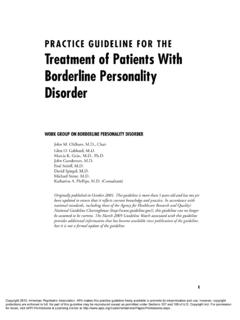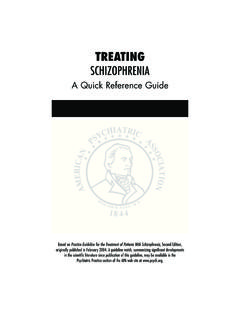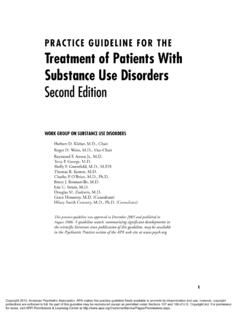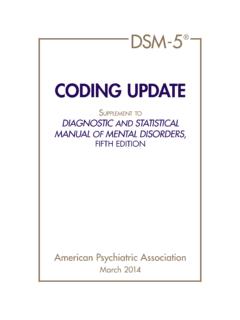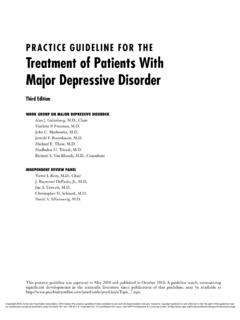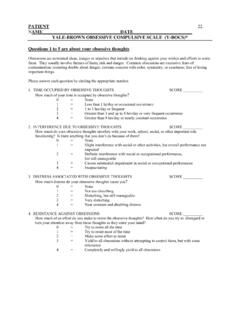Transcription of Avoidant/Restrictive Food Intake Disorder - Psychiatry
1 DSM-5 Update February 2020. Supplement to Diagnostic and Statistical Manual of Mental disorders , Fifth Edition Avoidant/Restrictive food Intake Disorder Diagnostic Criteria A. An eating or feeding disturbance ( , apparent lack of interest in eating or food ;. avoidance based on the sensory characteristics of food ; concern about aversive consequences of eating) as manifested by persistent failure to meet appropriate nutritional and/or energy needs associated with one (or more) of the following: 1. Significant weight loss (or failure to achieve expected weight gain or faltering growth in children).
2 2. Significant nutritional deficiency. 3. Dependence on enteral feeding or oral nutritional supplements. 4. Marked interference with psychosocial functioning. B. The disturbance is not better explained by lack of available food or by an associated culturally sanctioned practice. C. The eating disturbance does not occur exclusively during the course of anorexia nervosa or bulimia nervosa, and there is no evidence of a disturbance in the way in which one's body weight or shape is experienced. D. The eating disturbance is not attributable to a concurrent medical condition or not better explained by another mental Disorder .
3 When the eating disturbance occurs in the context of another condition or Disorder , the severity of the eating disturbance exceeds that routinely associated with the condition or Disorder and warrants additional clinical attention. Specify if: In remission: After full criteria for Avoidant/Restrictive food Intake Disorder were previously met, the criteria have not been met for a sustained period of time. Copyright 2020 American Psychiatric Association. All rights reserved. Unless authorized in writing by the American Psychiatric Association (APA), no part of this supplement may be reproduced or used in a manner inconsistent with the APA's copyright.
4 This prohibition applies to unauthorized uses or reproductions in any form, including electronic applications. Correspondence regarding copyright permissions should be directed to DSM Permissions, American Psychiatric Association Publishing, 800 Maine Ave. SW, Suite 900, Washington, DC 20024-2812. This February 2020 supplement contains updates that are effective immediately. It also includes content from prior updates that remains relevant to compensation and current clinical practice. This supplement is located at: DSM and DSM-5 are registered trademarks of the American Psychiatric Association.
5 Use of these terms is prohibited without permission of the American Psychiatric Association. ICD-9-CM codes were used for coding purposes in the United States through September 30, 2015. Because ICD-9- CM codes can no longer be used in the United States, they are not included in this DSM-5 Update. ICD-10-CM codes are used for coding purposes in the United States as of October 1, 2015. DSM-5 . UPDATE. Supplement to DIAGNOSTIC AND STATISTICAL. MANUAL OF MENTAL disorders , FIFTH EDITION. October 2018.. DSM-5 Update October 2018.
6 Supplement to Diagnostic and Statistical Manual of Mental disorders , Fifth Edition Copyright 2018 American Psychiatric Association. All rights reserved. Unless authorized in writing by the American Psychiatric Association (APA), no part of this supplement may be reproduced or used in a manner inconsistent with the APA's copyright. This prohibition applies to unauthorized uses or reproductions in any form, including electronic applications. Correspondence regarding copyright permissions should be directed to DSM Permissions, American Psychiatric Association Publishing, 800 Maine Ave.
7 SW, Suite 900, Washington, DC. 20024-2812. This supplement and the digital versions of DSM-5 (including the DSM-5 Diagnostic Criteria Mobile App, DSM-5 eBook, and DSM-5 on ) reflect any updates to diagnostic criteria and related text; coding updates, changes, or corrections; and any other information necessary for compensation in mental health practice. This supplement contains ICD-10-CM. updates that become effective on October 1, 2018. It also includes content from prior updates that remains relevant to compensation and current clinical practice.
8 This supplement is located at: DSM and DSM-5 are registered trademarks of the American Psychiatric Association. Use of these terms is prohibited without permission of the American Psychiatric Association. ICD-9-CM codes were used for coding purposes in the United States through September 30, 2015. Because ICD-9-CM codes can no longer be used in the United States, they are not included in this DSM-5 Update. ICD-10-CM codes are used for coding purposes in the United States as of October 1, 2015. Contents October 2018 ICD-10-CM Coding Updates at a Glance.
9 1. Prior ICD-10-CM Coding Updates at a Glance (2015 2017) ..2. October 2017 ICD-10-CM Coding Updates at a Glance ..2. October 2016 ICD-10-CM Coding Updates at a Glance ..6. October 2015 ICD-10-CM Coding Updates at a Glance ..7. Criteria Updates ..8. Neurodevelopmental disorders ..8. Autism Spectrum Disorder : Criterion A [August 2015]. Schizophrenia Spectrum and Other Psychotic Brief Psychotic Disorder : With Peripartum Onset Specifier [August 2015]. Substance/Medication-Induced Psychotic Disorder : Coding Note [October 2018].
10 Bipolar and Related disorders ..9. Bipolar I Disorder : Manic Episode, Criterion A [August 2015]. Bipolar I Disorder : Hypomanic Episode, Criterion F [August 2015]. Bipolar I Disorder : With Psychotic Features Specifiers [October 2018]. Bipolar II Disorder : Hypomanic Episode, Criterion F [August 2015]. Bipolar II Disorder With Melancholic Features and With Atypical Features Specifiers [August 2015]. With Psychotic Features Specifiers [October 2018]. With Seasonal Pattern Specifier [August 2015]. Severity Specifier [August 2015].



